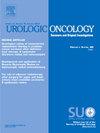OUTCOMES FOLLOWING NEOADJUVANT CISPLATIN-BASED CHEMOTHERAPY AND CYSTECTOMY FOR MUSCLE INVASIVE UROTHELIAL CARCINOMA WITH CONCOMITANT CARCINOMA IN SITU
IF 2.4
3区 医学
Q3 ONCOLOGY
Urologic Oncology-seminars and Original Investigations
Pub Date : 2025-03-01
DOI:10.1016/j.urolonc.2024.12.047
引用次数: 0
Abstract
Introduction
Neoadjuvant cisplatin-based chemotherapy (NAC) followed by radical cystectomy (RC) is a standard treatment for eligible patients with muscle invasive bladder cancer (MIBC). Studies on the effects of concomitant carcinoma in situ (CIS) at transurethral resection of bladder tumor (TURBT) before NAC are sparse and often limited by including non-cisplatin-based NAC, small samples, or multi-institutional data. Understanding the effect of concomitant CIS on final pathologic staging and survival outcomes is important. Thus, we aimed to compare complete response rates between patients with and without concomitant CIS with MIBC at TURBT using single-institution data from patients undergoing only cisplatin-based NAC prior to RC. We secondarily aimed to compare rates of other pathologic and oncologic outcomes as well.
Methods
This was a single institution retrospective cohort study using data from our prospectively maintained IRB approved database of patients who undergo RC. Patients with clinical stage T2-4aN0M0 MIBC with or without concomitant CIS at most recent TURBT (performed within and outside of our institution) who received at least three cycles of cisplatin-based NAC followed by RC between 2002-2024 were identified. The primary outcome of interest was rate of pathologic complete response (pCR) in patients with concomitant CIS at TURBT compared to those without. Secondary outcomes included comparison of residual CIS (pTis), nodal metastasis, lack of response to NAC (stable or upstage), overall survival, and recurrence free survival.
Results
346 patients (predominantly male (n=280, 80.9%), average age 66.3 (SD=9.2)) who had a median of 25.3 (IQR: 182-1629) months of follow-up were included. Among these patients, 78 (22.5%) had concomitant carcinoma in situ (CIS), while 268 (77.5%) did not. A higher percentage of patients without concomitant CIS received gemcitabine-cisplatin compared to those with concomitant CIS (75.7% vs. 64.1%, p=0.041). Patients with concomitant CIS had longer follow-up than patients without concomitant CIS (37.7 months vs. 18.4 months, p=0.03). The cohorts did not significantly differ in any other baseline characteristics. On multivariable analyses, concomitant CIS was not associated with pCR (OR=0.57, 95% CI=[0.30-1.07], p=0.089), pTisN0M0 (OR=1.68, 95% CI=[0.77-3.60], p=0.185), nodal metastasis (OR=0.86, 95% CI=[0.36-1.92], p=0.719), or lack of response to chemotherapy (OR=1.24, 95% CI=[0.65-2.46], p=0.522). Concomitant CIS was also not significantly associated with overall survival (HR 0.58, 95% CI [0.32-1.05], p=0.07) or recurrence free survival (HR 0.67, [0.38-1.18], p=0.163).
Conclusions
The presence of CIS in the setting of MIBC has no impact on complete response to NAC, pathologic outcomes, overall survival, or recurrence free survival. The current study is the largest single-institution study, and the only study with all patients receiving at least three cycles of only cisplatin-based NAC to assess the effect of concomitant CIS at TURBT for MIBC. The presence of concomitant CIS should not alter treatment decisions regarding NAC in patients with MIBC.
以顺铂为基础的新辅助化疗和膀胱切除术治疗伴有原位癌的肌肉侵袭性尿路上皮癌的结果
新辅助顺铂化疗(NAC)加根治性膀胱切除术(RC)是肌肉浸润性膀胱癌(MIBC)患者的标准治疗方法。在NAC前经尿道膀胱肿瘤切除术(TURBT)中合并原位癌(CIS)的影响的研究很少,而且常常受到非顺铂基NAC、小样本或多机构数据的限制。了解合并CIS对最终病理分期和生存结果的影响是很重要的。因此,我们的目的是比较TURBT伴有CIS和不伴有MIBC的患者的完全缓解率,使用的是在RC之前仅接受顺铂NAC的患者的单机构数据。我们的第二个目的是比较其他病理和肿瘤结果的比率。方法:这是一项单机构回顾性队列研究,数据来自我们前瞻性维护的IRB批准的接受RC的患者数据库。在最近的TURBT(在我院内外进行)中,临床分期为T2-4aN0M0的MIBC伴有或不伴有CIS的患者在2002-2024年期间接受了至少三个周期的顺铂类NAC和RC。研究的主要终点是在TURBT合并CIS患者与未合并CIS患者的病理完全缓解率(pCR)。次要结局包括比较残余CIS (pTis)、淋巴结转移、对NAC缺乏反应(稳定或晚期)、总生存期和无复发生存期。结果纳入346例患者,男性为主(n=280, 80.9%),平均年龄66.3 (SD=9.2),中位随访25.3个月(IQR: 182 ~ 1629)。其中78例(22.5%)合并原位癌,268例(77.5%)未合并原位癌。与合并CIS的患者相比,未合并CIS的患者接受吉西他滨-顺铂治疗的比例更高(75.7%对64.1%,p=0.041)。合并CIS的患者随访时间较不合并CIS的患者长(37.7个月对18.4个月,p=0.03)。两组在其他基线特征上没有显著差异。在多变量分析中,合并CIS与pCR (OR=0.57, 95% CI=[0.30-1.07], p=0.089)、pTisN0M0 (OR=1.68, 95% CI=[0.77-3.60], p=0.185)、淋巴结转移(OR=0.86, 95% CI=[0.36-1.92], p=0.719)或对化疗缺乏反应(OR=1.24, 95% CI=[0.65-2.46], p=0.522)无关。合并CIS与总生存率(HR 0.58, 95% CI [0.32-1.05], p=0.07)或无复发生存率(HR 0.67, [0.38-1.18], p=0.163)也无显著相关性。结论:在MIBC患者中,CIS的存在对NAC的完全缓解、病理结果、总生存期或无复发生存期没有影响。目前的研究是最大的单机构研究,也是唯一一项所有患者都接受至少三个周期的仅顺铂为基础的NAC的研究,以评估在TURBT时合并CIS对MIBC的影响。伴有CIS的存在不应改变MIBC患者NAC的治疗决定。
本文章由计算机程序翻译,如有差异,请以英文原文为准。
求助全文
约1分钟内获得全文
求助全文
来源期刊
CiteScore
4.80
自引率
3.70%
发文量
297
审稿时长
7.6 weeks
期刊介绍:
Urologic Oncology: Seminars and Original Investigations is the official journal of the Society of Urologic Oncology. The journal publishes practical, timely, and relevant clinical and basic science research articles which address any aspect of urologic oncology. Each issue comprises original research, news and topics, survey articles providing short commentaries on other important articles in the urologic oncology literature, and reviews including an in-depth Seminar examining a specific clinical dilemma. The journal periodically publishes supplement issues devoted to areas of current interest to the urologic oncology community. Articles published are of interest to researchers and the clinicians involved in the practice of urologic oncology including urologists, oncologists, and radiologists.

 求助内容:
求助内容: 应助结果提醒方式:
应助结果提醒方式:


